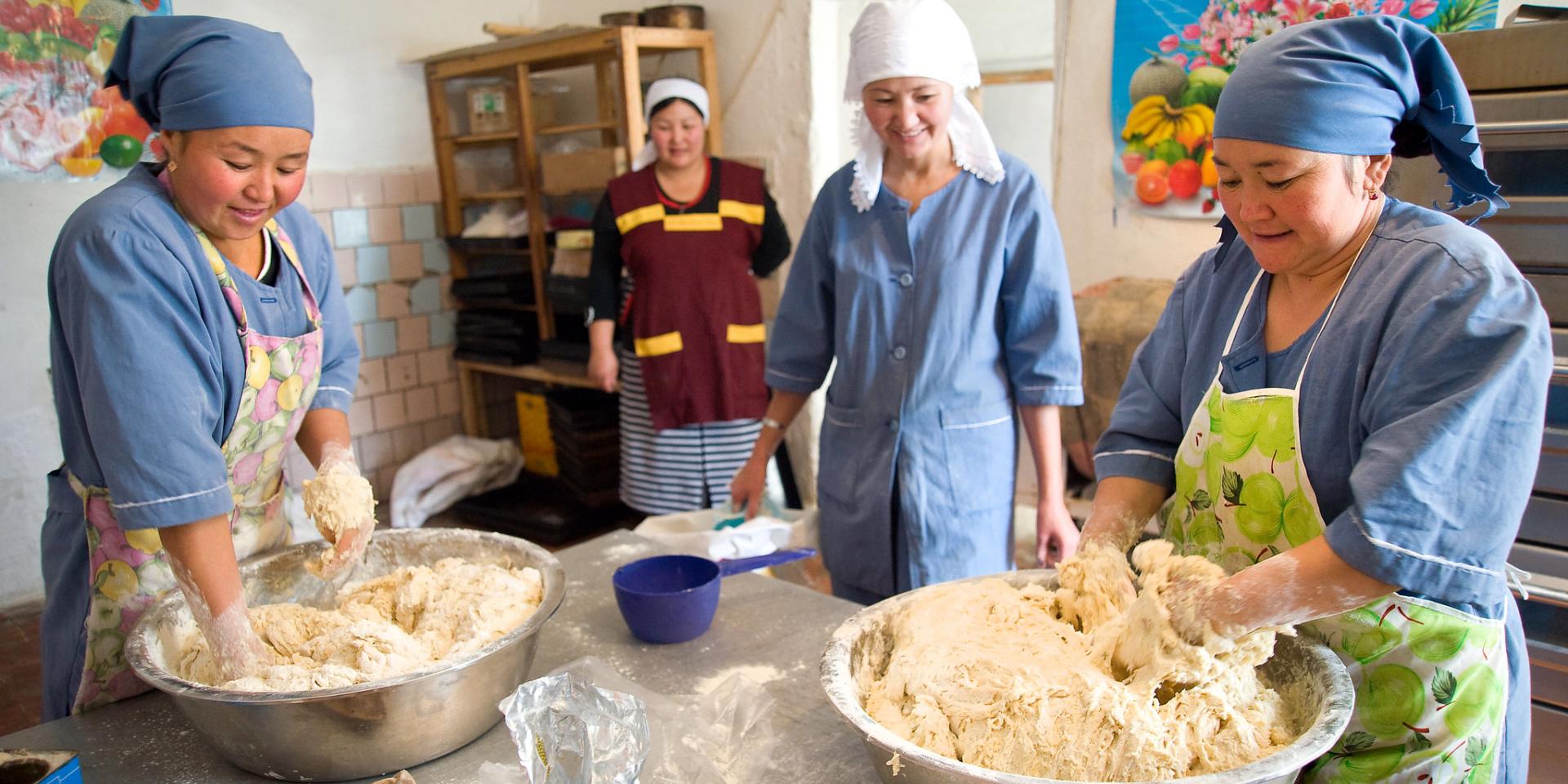Top 10 reads on gender and entrepreneurship
 Photo: David Snyder/UN Women
Photo: David Snyder/UN Women
A series of recommended reading lists provide starting points for researchers, students, practitioners, and others looking to dive deeper into research on gender and a wide variety of topics.
In this list, we take a closer look at the recommended reading on gender and entrepreneurship.
Entrepreneurship is one of the key pathways of socioeconomic advancement and can be a driver of equality and economic growth for different social groups across economies in the global South and North. Research on gender and entrepreneurship has increased over the past two decades due to interest from development practitioners and academics. Below are 10 papers looking at conceptual, methodological and empirical insights on gender and entrepreneurship in developed and developing countries in the past decades.
Setting the scene for gender and entrepreneurship
#1
In “Gender and entrepreneurship: a review and process model”, Sullivan and Meek (2012) provide a nuanced understanding of gender and entrepreneurship using a micro-oriented process model. Their paper reviews literature from 1993 to 2010 on women’s choices about entrepreneurship based on motivation, ability to identify opportunities, resource acquisition and entrepreneurial success or performance at pre-launch, launch and post-launch levels. The authors point out that women’s motivation to pursue entrepreneurship is more diverse than men’s because their expectations are more multifaceted, with women highly valuing autonomy, independence, work-life balance and self-actualization. Women also rely more on friends or family and knowledge of previous work experience in identifying entrepreneurial opportunities compared to men. Women’s choice of lower-capital industries might not only be influenced by limited access to resources, but also the need to succeed. While internal motivations (desire to be their own boss) were stronger for women’s successful business launch, external motivations (identifying a market need) were stronger for men. Lastly, women view entrepreneurship as a means to achieve autonomy, independence and a more effective work- and family-life balance.
#2
Cardella et al. (2020), in “Women entrepreneurship: A systematic review to outline the boundaries of scientific literature”, advocate for the study of women and entrepreneurship as a construct on its own and not always in contrast to their men counterpart. The researchers recognized that women’s entrepreneurship is varied and rich in nuances. Women entrepreneurs are not a homogeneous group, so there is need to account for the heterogeneity of women entrepreneurs. Thus, an intersectional lens is needed when looking at women’s entrepreneurship. The authors also call for a rigorous mixed-method and feminist theoretical approach to analyze different nuances and peculiarities of women’s entrepreneurship. Lastly, there is a call for further studies on constraints women’s enterprises face at later stages of their business.
Novel methodological approaches to understanding gender and entrepreneurship
#3
In “Gender and entrepreneurship research: A review of methodological approaches”, Henry et al. (2016) argue that despite the shift toward feminist critiques of entrepreneurship, most literature still reports studies that only compare women and men, with little attention paid to gender constructs. In addition, there is an over-reliance on cross-sectional studies with small sample sizes often emphasizing women’s subordinate role. This paper insists that a shift in the conceptualization of gender and entrepreneurship should be matched with an appropriate shift in methodological approaches – mixed methods, especially qualitative research methods (in-depth interviews, life histories, case studies) and an explicitly feminist agenda. There is a need to question assumed constructions of gender and how it is performed.
#4
Ogundana et al. (2021) in “Women entrepreneurship in developing economies: A gender-based growth model” readapted the “6 Ms model” (motherhood, money, market, management, meso-environment and micro-environments) to test, contextualize and extend our understanding of business growth of women entrepreneurs in West African settings. The model readaptation revealed that access to and use of money positively influenced the growth of women’s enterprise in terms of assets, workforce and clientele. Nonformal education and past working experience were considered important but short lived as new competencies were needed as the business grew. Customer feedback and intelligence were considered key to business growth. Motherhood positively and negatively influenced the growth of women-owned enterprises, especially depending on whether the women were supported by their relatives and spouses. The meso-environment – social groups – provided them training sessions and interest-free loans that positively impacted their skills. Lastly, sociocultural norms and external economic conditions both negatively and positively affected women’s businesses.

Women sell fufu, staple food in Nigeria, at market in Abuja. (Photo: Milo Mitchell/IFPRI)
Looking beyond the women-and-men binary to youths
#5
The face of the developing world is predominantly young, placing young people at the center of national, regional and global agendas. Tapping into the potential of young people is critical for sustained economic growth and societal well-being. This Future potential report, by Schøtt and Cheraghi (2015), provides a deeper understanding of gender differences in youth entrepreneurial behavior and enterprise. While youths as a group show significantly higher levels of entrepreneurial intention than adults (1.6 times higher), the older youth category has a relatively high level of actual entrepreneurial activity compared to younger youths. Young men engage in early-stage entrepreneurial activity compared to young women who mostly get into entrepreneurship out of necessity. Youth in sub-Saharan Africa has the highest levels of established business activity compared to other regions. Sub-Saharan Africa and the Middle East and North Africa region have the highest prevalence of necessity-motivated enterprises. Recently, the authors argue, a global shift in social values, norms and institutions have promoted entrepreneurship among youths through institutional arrangements such as incubators, education and entrepreneurial-skill training to nurture their self-efficacy, opportunity alertness and risk willingness. Research gaps identified are a lack of focus on unemployed youths and young individuals’ transition from intention to starting an entrepreneurial venture.
#6
Even though youth entrepreneurship is key, youth face constraints such as unfavorable government policies, limited access to finance, limited access to the market, limited access to information and infrastructure, limited access to business assistance and support, limited access to entrepreneurship training and education, lack of social support, unfavorable administrative and weak institutional linkages. Ahmed and Ahmed propose, in “Constraints of youth entrepreneurs in Ethiopia” (2021), context-specific, multi-faceted, multi-targeted and multi-tier approaches to facilitate and encourage youth entrepreneurship.
Gaps, barriers and opportunities for women’s entrepreneurship
#7
The Women's Entrepreneurship Report 2018/2019 identifies countries and regions where the gender gap may be significant and where it may be closing (Elam et al. 2019). It further examines how structural factors and industry distribution or segregation influence women’s entrepreneurship and how women are influencing ecosystems both as entrepreneurs and investors. The highest rates of so-called total entrepreneurial activity and established business ownership for women are found in sub-Saharan Africa (at 21.8 percent, compared to Latin America (17.3 percent), Europe (6 percent) and MENA regions (9 percent)), and the gender gap for entrepreneurial intentions is closest to parity in low-income countries at an 86 percent women-to-men ratio. The average global rate for business discontinuance is highest in low-income countries and about 10 percent lower for women (2.9 percent) than for men (3.2 percent). The largest gender gaps are still within the areas of agriculture, mining, and information and communications technology, where men entrepreneurs are more than twice as likely to operate as women. The authors recommend embracing a more inclusive vision of entrepreneurship, using realistic data to guide the development of an ecosystem that works for all.
#8
Women’s entrepreneurship is especially challenging in developing countries because women here have limited access to opportunities and resources, and they face unique sociocultural, economic and political challenges. Some of these challenges arise from gender discrimination, work-family conflicts, internal fears, insecurities, difficulty in raising capital, lack of infrastructural support, unstable business, economic and political environments, lack of training and education and personality differences, according to “Constraints faced by women entrepreneurs in developing countries: review and ranking” (Swati 2018). The constraints mentioned above are not isolated, but are interrelated, reinforcing one another and resulting in multiple negative consequences such as lower growth rate, smaller business sizes and reduced profitability for women-led ventures.
Women’s empowerment through entrepreneurship
#9
In this book chapter, “Gender inequality and female entrepreneurship in developing countries”, Olarewaju and Fernando (2020) highlight the backseat position historically given to women entrepreneurship due to the small-scale nature of their enterprises. The authors argue that measuring entrepreneurial outcomes using economic indicators alone overlooks many ways women’s entrepreneurship contributes to women’s empowerment (defined as an outcome of women’s individual and collective action through entrepreneurship). It also fails to account for gender power relations, women’s multiple roles that structurally discriminate against women entrepreneurs, and the crucial role women play in changing these discriminatory structures of oppression. The authors call for more studies on noneconomic outcomes of women’s entrepreneurship, such as individual agency, autonomy, improved livelihoods and a better work-family balance. They suggest a look at four noneconomic indices of entrepreneurial success: performance, workplace relationships, personal fulfilment and community impact contributing toward women’s social inclusion and gender parity.
#10
In “‘And now I’m free’: Women’s empowerment and emancipation through entrepreneurship in Saudi Arabia and Sweden”, Alkhaled and Berglund (2018) have investigated women entrepreneurs on their “road to freedom”, using life stories to attain “freedom”, “autonomy” and “empowerment”. Authors argued that entrepreneurial activity enabled most of the women to break free from gendered constraints toward empowerment. Empowerment and disempowerment were not static and were influenced by spousal and family support and by informal institutions. Education, employment and family support (in this paper from the fathers and sisters, not husbands) guided women toward “freedom” for themselves and other women through self-employment. The authors also explained that women’s attempts to be free themselves from the power of others were only partial and embedded within diverse institutional structures, from which they can break free if these power structures are destabilized. Empowerment could contribute to emancipation through collective action by engaging women and institutional structures.
References
Gender and entrepreneurship: a review and process model
Sullivan, D. M., & Meek, W. R. (2012). Gender and entrepreneurship: a review and process model. Journal of managerial psychology. http://dx.doi.org/10.1108/02683941211235373
Women entrepreneurship: A systematic review to outline the boundaries of scientific literature
Cardella, G. M., Hernández-Sánchez, B. R., & Sánchez-García, J. C. (2020). Women entrepreneurship: A systematic review to outline the boundaries of scientific literature. Frontiers in psychology, 11, 1557. https://doi.org/10.3389/fpsyg.2020.01557
Gender and entrepreneurship research: A review of methodological approaches
Henry, C., Foss, L., & Ahl, H. (2016). Gender and entrepreneurship research: A review of methodological approaches. International Small Business Journal, 34(3), 217-241. https://doi.org/10.1177/0266242614549779
Women entrepreneurship in developing economies: A gender-based growth model
Oyedele Martins Ogundana, Amon Simba, Leo-Paul Dana & Eric Liguori (2021) Women entrepreneurship in developing economies: A gender-based growth model, Journal of Small Business Management, 59:sup1, S42-S72, https://doi.org/10.1080/00472778.2021.1938098
Future Potential. A GEM perspective on youth entrepreneurship
Schøtt, T., Kew, P., & Cheraghi, M. (2015). Future potential. A GEM perspective on youth entrepreneurship. https://www.theark.ch/media/document/0/gem-2015-youth-report-1438012592.pdf. Accessed on the 2nd of May 2022.
Constraints of youth entrepreneurs in Ethiopia
Ahmed, H., & Ahmed, Y. A. (2021). Constraints of youth entrepreneurs in Ethiopia. Journal of Global Entrepreneurship Research, 1-10. https://doi.org/10.1007/s40497-021-00292-z
Women's Entrepreneurship Report 2018/2019
Elam, Amanda B.; Brush, Candida G.; Greene, Patricia G.; Baumer, Benjamin; Dean, Monica; Heavlow, René; Babson College; Smith College; and Global Entrepreneurship Research Association (GERA), "Women's Entrepreneurship Report 2018/2019" (2019). Report, Smith College, Northampton, MA. https://scholarworks.smith.edu/conway_research/4
Constraints faced by women entrepreneurs in developing countries: review and ranking
Swati Panda, (2018) "Constraints faced by women entrepreneurs in developing countries: review and ranking", Gender in Management: An International Journal, https://doi.org/10.1108/GM-01-2017-0003
Gender Inequality and Female Entrepreneurship in Developing Countries
Olarewaju, T., & Fernanado, J. (2020) Gender Inequality and Female Entrepreneurship in Developing Countries. In: Decent Work and Economic Growth. Encyclopedia of the UN Sustainable Development Goals. Springer, Switzerland. ISBN 978-3-319-71058-7. https://doi.org/10.1007/978-3-319-71058-7_92-1
‘And now I’m free’: Women’s empowerment and emancipation through entrepreneurship in Saudi Arabia and Sweden
Sophie Alkhaled & Karin Berglund (2018) ‘And now I’m free’: Women’s empowerment and emancipation through entrepreneurship in Saudi Arabia and Sweden, Entrepreneurship & Regional Development, 30:7-8, 877-900, https://doi.org/10.1080/08985626.2018.1500645


